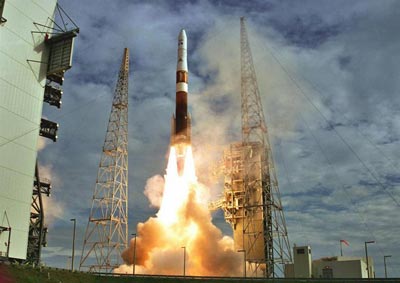United Launch Alliance: a good idea or a necessary evil?by Taylor Dinerman
|
| Whether the ULA joint venture goes through or not, there seems, at first glance, precious little room for creativity in the EELV program. |
A closer look at the nature of the space launch business over the next ten years suggests that there is enough elbow room for both the Atlas 5 and the Delta 4 to survive and perhaps thrive. The NASA Commercial Orbital Transportation System (COTS) project for ISS resupply may provide them with an important new market. There is also the possibility that the US military may decide that it really does need on-orbit spare satellites. More launches will mean lower costs per flight and that, in turn, will allow both rockets to better compete against their foreign competitors.
Even with more launches it is doubtful that both EELVs will ever become the commercially-viable launch vehicles that they were expected to be when the program was designed in the mid-1990s. At the time the Pentagon and the contractors vastly overestimated the demand for launch services, particularly for telecommunications satellites. This lead to Boeing making a huge infrastructure investment in its Decatur plant, built near Huntsville, in the heart of Alabama’s rocket country.
If ULA is ever to be even remotely a success, it will be mostly due to its ability to take advantage of this huge facility. It was built in the late 1990s as a state-of-the-art, “lean manufacturing” plant with easy access to a waterway where the Delta 4 cores can be loaded onto barges for shipping to Florida. Today this plant is seriously underused. If ULA can integrate the Atlas 5 production line into the operation there, as proposed, some of the promised synergies might actually be realized.
So far only five Delta 4s have been launched, as opposed to eight successful Atlas 5s. Thirteen total launches since August 2002 is not the best record to build on. The EELV program has proven costly and frustratingly slow. That is not all the fault of the launch system: payload problems have been far more of a factor than the rockets themselves. Even worse have been the difficulties that both the DoD and NASA have had in finding enough payloads to make the project viable at a reasonable cost per flight. If programs such as the Air Force’s Space Based Infrared System (SBIRS) or the NRO’s Future Imagery Architecture (FIA) had been kept on something like their original schedule then the EELVs might have a far better operational history.
Sources indicate that the latest Rand study of the EELV problem concludes that there is a need for both launch systems and that both systems are technologically solid and have the potential to be highly reliable. Together, they fulfill the original program requirement to provide assured access to space for US national security space assets. The US never again wants to be in the position it was in during the late 1980s when for more than a year it had no way of getting its military satellites into orbit.
The idea that the programs have to be merged in order to save money supposedly originated in the Air Force rather than in the companies themselves. This makes sense since it matters little to either Boeing or Lockheed Martin who runs the programs since they will get paid anyway or will leave the business. Their priorities are to make money and please their one big customer, the US government. Those who object to the ULA on the grounds that it creates a monopoly would have a better case if the contractors were in a position of real strength vis-à-vis the Pentagon and NASA. These are hardly 98-pound corporate weaklings, but they do not, and cannot, deal with the government as equals.
For the space industry the biggest problem with ULA is the length of time it is taking for the US government to give the project the final go-ahead. This delay has played havoc with the lives and careers of dozens of highly-qualified technicians, engineers, scientists, and managers. These people are stuck in limbo waiting for the word to either move forward or to find another job. In some cases, important individuals are reported to have left the industry entirely rather than wait around while the government makes up its mind. This tendency of the government to toy with peoples’ lives is all too common and has had a negative effect on the effort to create and maintain a stable, high-quality space industry workforce.
| The ULA delay has played havoc with the lives and careers of dozens of highly-qualified technicians, engineers, scientists, and managers. These people are stuck in limbo waiting for the word to either move forward or to find another job. |
It now seems that the Defense Department is moving towards a definitive decision. If, as expected, this is a positive one, it does not mean that the EELV program has smooth sailing ahead. Instead, there is not only a requirement to maintain the successful record of both vehicles, but there is also a need to constantly improve the quality and capabilities of the hardware. In the near future it may be necessary to human-rate one or both vehicles, either as part of the follow-on to COTS program or as a substitute for NASA’s Crew Launch Vehicle if anything goes wrong with that program.
Stabilizing the management of the EELV program and giving it a chance to prove itself should be the US government’s current priority. Once that is accomplished then the DoD and NASA can take another look at the neglected field of launch vehicle technology development, where there are urgent needs for investments in basic research.
